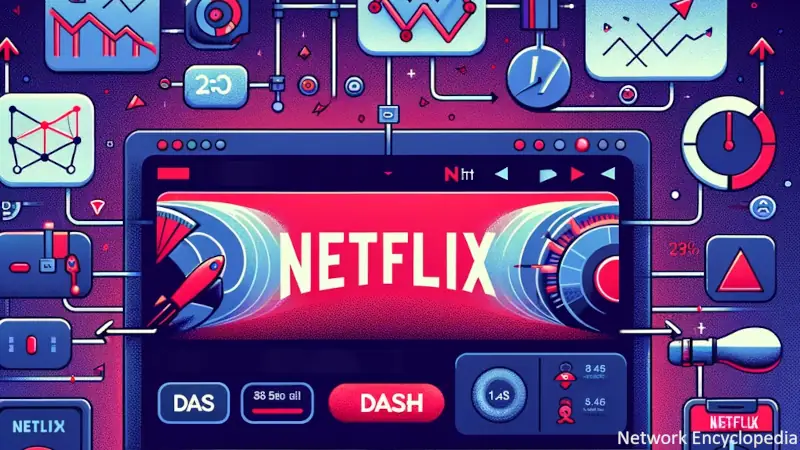In the fast-evolving world of digital media, ensuring seamless streaming experiences across diverse network conditions and device capabilities is paramount. Dynamic Adaptive Streaming over HTTP, commonly referred to as DASH or the DASH protocol, addresses this challenge by enabling high-quality media delivery without the need for complex server-side infrastructure. This article will decode the mechanisms that make DASH a pivotal technology in modern streaming, detailing its operations, benefits, and implementation. By dissecting its architecture and practical applications, we’ll provide a thorough understanding of how DASH adapts to varying internet speeds, ensuring optimal viewer experiences across platforms.
Table of Contents:
- What is Dynamic Adaptive Streaming over HTTP (DASH)?
- How Does DASH Work?
- Key Features and Benefits of DASH
- DASH vs. Other Streaming Protocols
- Implementing DASH: Technical Considerations
- Case Studies: DASH in Action
- Future Trends and Developments in DASH
- References

1. What is Dynamic Adaptive Streaming over HTTP (DASH)?
Dynamic Adaptive Streaming over HTTP (DASH) is a streaming technique that allows for the efficient delivery of multimedia content over the Internet. Designed to be flexible and highly efficient, DASH is an adaptive bitrate streaming technology that dynamically adjusts the quality of a video stream in real-time according to changes in network conditions and video playback capabilities.
At its core, DASH operates by dividing multimedia content into small, downloadable segments, each containing a short burst of playback data. These segments are encoded at various quality levels, commonly known as representations. The key to DASH’s adaptability lies in its use of a manifest file, formally called the Media Presentation Description (MPD). This XML file serves as a roadmap, detailing the different representations available and their respective metadata, including bitrates, resolution, and codec information.

When a client device begins streaming, it initially requests the MPD from the server. The client then uses this information to make intelligent decisions about which segments to download based on current network conditions, available bandwidth, and user settings. This decision-making process is crucial as it strives to balance the highest possible video quality with the smoothest, uninterrupted playback.
Unlike traditional streaming methods that rely on a continuous stream of data, DASH’s segment-based approach minimizes buffering and improves the quality of experience for viewers. By adjusting video quality dynamically, DASH can effectively mitigate issues like buffering and video degradation during network congestion, making it ideal for fluctuating internet speeds.
DASH is not confined to any specific codec, supporting a wide range of audio and video codecs. This flexibility makes it universally compatible with a variety of content creation and delivery scenarios, extending its applicability from simple web streaming to complex broadcast environments.
In summary, Dynamic Adaptive Streaming over HTTP is engineered to provide an optimal balance between quality and performance in video streaming environments. Its design is especially beneficial in our increasingly mobile world, where users expect high-quality streaming on various devices under varying network conditions. By the end of this chapter, readers will have a foundational understanding of DASH, setting the stage for deeper exploration into its operational mechanisms and practical implementations in subsequent sections.
2. How Does DASH Work?
Dynamic Adaptive Streaming over HTTP (DASH) operates on a principle that is elegantly simple yet technically robust, involving the interaction between a client and a server over standard HTTP web protocols. The process begins when the client requests and retrieves the Media Presentation Description (MPD) from the server. The MPD is a critical component of DASH, acting as a manifest that outlines all available media files, their corresponding quality levels, and other necessary metadata.
Segmentation:
The foundation of DASH’s functionality is the division of multimedia content into a series of small, discrete segments. Each segment typically ranges from a few seconds to several minutes in duration. These segments are encoded at various quality levels—each with different bitrates and resolutions to accommodate varying network conditions and playback capabilities.
Adaptive Bitrate Streaming:
After downloading the MPD, the client employs an adaptive bitrate streaming technique. It continuously monitors network conditions, such as bandwidth and throughput, and dynamically selects the appropriate quality of video segments to download. This adaptive process is managed by the client’s adaptive bitrate algorithm, which decides the optimal segment to fetch next based on current conditions, aiming to minimize buffering while maximizing media quality.
Client-Driven Decisions:
The client-driven nature of DASH is a significant departure from traditional streaming technologies that rely on server-side logic to manage stream quality. In DASH, the client has the autonomy to switch between different bitrates seamlessly, enhancing the viewer’s experience by adapting the stream to suit their device and network environment without any manual input.
Downloading and Playback:
As the client plays the downloaded segments, it continues to download subsequent segments in the background. This ensures a buffer that accommodates for any potential delays in network response or fluctuations in bandwidth. The client can also preemptively lower the quality of downloaded segments if it detects a decrease in available bandwidth, thus avoiding pauses in playback.
This workflow not only optimizes the viewer’s experience by reducing interruptions and enhancing video quality but also efficiently uses network resources, avoiding the waste of bandwidth on excessively high-quality streams that the network cannot support.
3. Key Features and Benefits of DASH
Flexibility and Compatibility
One of the standout features of DASH is its codec-agnostic framework, which supports a wide variety of audio and video codecs. This flexibility allows content providers to use DASH across multiple platforms and devices, from smartphones to high-definition televisions, without being tied to specific technologies or proprietary systems.
Efficiency and Scalability
DASH enhances the efficiency of video delivery by using standard HTTP servers and protocols, which are ubiquitous and well-optimized across the internet. This approach leverages existing infrastructure, which can scale effectively to meet high demand without the need for specialized servers or additional network equipment.
Cost-Effectiveness
By utilizing regular HTTP traffic, DASH reduces the cost associated with delivering streaming content. Traditional streaming technologies often require specialized delivery systems and network configurations, which can be costly to set up and maintain.
Improved User Experience
The adaptive streaming capability of DASH ensures that viewers experience the highest possible video quality that their network condition can support at any given time. This adaptability is crucial for maintaining smooth playback without buffering, particularly when network conditions are variable or unpredictable.
Resource Optimization
DASH’s intelligent bitrate adaptation not only benefits users by providing an optimal viewing experience but also helps service providers manage and allocate bandwidth more efficiently. By delivering only the most appropriate stream quality, DASH minimizes unnecessary data transfers, which can significantly reduce overall network load and operational costs.
In summary, the key features and benefits of DASH center around its adaptability, efficiency, and broad compatibility. These attributes make DASH a compelling choice for content providers looking to offer a superior streaming experience while managing costs and leveraging existing web infrastructure.
4. DASH vs. Other Streaming Protocols
Dynamic Adaptive Streaming over HTTP (DASH) is one of several adaptive bitrate streaming technologies designed to deliver video content over the internet efficiently. However, DASH distinguishes itself from other protocols like Apple’s HTTP Live Streaming (HLS), Microsoft’s Smooth Streaming, and Adobe’s HTTP Dynamic Streaming (HDS) through several key aspects:
Interoperability and Standardization
Unlike HLS, Smooth Streaming, and HDS, which are proprietary protocols developed by specific companies, DASH is an international standard. It has been developed by the ISO/IEC Moving Picture Experts Group (MPEG) and is not tied to any single vendor or platform. This standardization promotes broader compatibility and encourages adoption across various devices and media players.
Codec Agnosticism
DASH is designed to be codec-independent, meaning it can support a wide range of audio and video codecs. This is a contrast to protocols like HLS, which traditionally has been more restrictive in codec support (initially supporting only H.264 and AAC). Codec agnosticism allows content providers more flexibility in how they encode their content, potentially enabling higher efficiencies or better quality.
Manifest Flexibility
The MPD of DASH provides more flexibility compared to the manifest files used in HLS (m3u8 playlists). The DASH MPD can describe more complex presentation structures, offer more information about each stream, and better support for advanced features like multiple language tracks, subtitles, and advertisements.
Efficiency and Performance
DASH can potentially offer better network performance by using more efficient algorithms to adjust the bitrate of the video streams dynamically. This is partly due to the finer-grained control over segment sizes and bitrates than some other protocols, which can lead to more precise adaptation to changing network conditions.
While DASH has many advantages, it is important to recognize that the choice of streaming protocol can depend on specific use cases, target audience, and existing infrastructure. For instance, HLS is widely supported on Apple devices and may be preferable in ecosystems dominated by Apple products.
5. Implementing DASH: Technical Considerations
Implementing Dynamic Adaptive Streaming over HTTP requires careful consideration of various technical elements to ensure efficient and scalable video delivery. Here are key considerations for implementing DASH:
Encoding and Segmenting Content
Properly encoding and segmenting video content is crucial for DASH. Content must be encoded at various bitrates and resolutions to create multiple adaptive streams. These streams are then segmented into small, manageable chunks, typically ranging from 2 to 10 seconds each. Efficient segmentation helps in achieving smooth transitions in video quality during playback.
Creating the Media Presentation Description (MPD)
The MPD is the heart of a DASH implementation. Crafting a well-structured MPD involves detailing all available streams, segment information, and other metadata essential for adaptive playback. The MPD must be accurate and comprehensive to ensure that the client devices can make informed decisions about which segments to download.
Network and Server Infrastructure
Although DASH uses standard HTTP protocols, the network and server infrastructure must be robust enough to handle potentially high volumes of HTTP requests, especially during peak viewing times. Using content delivery networks (CDN) can help distribute the load and reduce latency, improving the overall user experience.

Client-Side Logic
The client-side player must be equipped with a sophisticated adaptive bitrate algorithm capable of deciding which segments to request based on current network conditions, buffer status, and user preferences. This component is critical for optimizing the viewing experience and making the most out of the DASH protocol.
Cross-Platform Compatibility
Ensuring compatibility across different devices and platforms is essential. Testing on various devices, operating systems, and browsers is crucial to address compatibility issues, given the wide range of DASH support across different platforms.
Security Considerations
Protecting streaming content is also a priority. Implementing DRM (Digital Rights Management) solutions compatible with DASH, such as Widevine or PlayReady, can help secure content delivery and prevent unauthorized access.
In conclusion, implementing DASH involves a comprehensive approach encompassing content preparation, MPD creation, infrastructure readiness, sophisticated client logic, and ensuring compatibility and security. By addressing these areas, service providers can leverage DASH to deliver high-quality streaming experiences that meet the demands of today’s diverse and dynamic digital media landscape.
6. Case Studies: DASH in Action
Dynamic Adaptive Streaming over HTTP (DASH) has been implemented across various high-profile and technically diverse scenarios. These case studies illustrate the protocol’s versatility and effectiveness in delivering optimal streaming experiences.
Netflix
As one of the largest streaming service providers, Netflix uses DASH to optimize content delivery across millions of devices globally. By using a combination of DASH and its own adaptive bitrate algorithms, Netflix ensures that each viewer receives the best possible video quality based on their internet connection, reducing buffering and improving satisfaction.

YouTube
Google’s YouTube has adopted DASH to enhance its video streaming capabilities. This implementation allows YouTube to efficiently manage the enormous volume of video traffic it receives daily. DASH enables YouTube to deliver videos dynamically at various quality levels, ensuring smooth playback on both high-speed and slower internet connections.
BBC iPlayer
The BBC iPlayer leverages DASH to offer live and on-demand streaming of television and radio content. This use case highlights DASH’s applicability in a broadcast setting, providing viewers with a high-quality, buffer-free experience even during peak viewing times.
Live Sports Streaming
Many sports broadcasting services use DASH for live event streaming. The protocol’s ability to adjust to real-time changes in network bandwidth ensures that sports fans enjoy the best possible viewing experience without interruptions, which is crucial during high-stakes moments.
These implementations underscore DASH’s adaptability and its capability to meet diverse needs—from on-demand video services to live broadcasting, DASH proves effective in various contexts, enhancing viewer engagement and platform reliability.
7. Future Trends and Developments in DASH
The future of Dynamic Adaptive Streaming over HTTP (DASH) appears promising, with several trends likely to shape its evolution:
Increased Use of Artificial Intelligence
AI technologies are expected to further optimize DASH implementations. By predicting network conditions and viewer preferences, AI can enhance the decision-making process behind adaptive bitrate streaming, potentially reducing bandwidth usage while improving viewer experience.
5G Technology
The rollout of 5G networks will dramatically increase internet speeds and reduce latency. DASH will need to adapt to these faster network conditions, potentially supporting higher-quality streams and more responsive bitrate adjustments.
Enhanced Personalization
Future developments in DASH may focus on delivering personalized streams that cater to individual preferences and device capabilities more effectively. This could involve adaptive audio tracks, user-specific ad insertions, and customized content recommendations.
Integration with Virtual Reality (VR) and Augmented Reality (AR)
As VR and AR technologies gain popularity, DASH may play a crucial role in streaming immersive media content. The ability to dynamically adjust the quality of complex video frames will be essential for maintaining an engaging and realistic VR/AR experience.
Sustainability Concerns
With increasing awareness of environmental impacts, optimizing data transmissions to reduce energy consumption will become a crucial aspect of streaming technologies like DASH. More efficient encoding and streaming algorithms will be needed to minimize the carbon footprint of digital media consumption.
8. References
- Books:
- “HTTP Live Streaming: A Practical Guide” by Ernesto Exposito – Although primarily about HLS, this book provides useful comparisons and foundational knowledge applicable to DASH.
- “Advanced Content Delivery, Streaming, and Cloud Services” edited by Mukaddim Pathan, Ramesh K. Sitaraman, and Dom Robinson – This collection covers a wide range of topics in modern streaming technologies including DASH.
- RFCs and Standards:
- ISO/IEC 23009-1: “Dynamic adaptive streaming over HTTP (DASH) — Part 1: Media presentation description and segment formats” – The primary standard defining DASH.
- RFC 8216: “HTTP Live Streaming” – While focused on HLS, this RFC provides context that is beneficial for understanding streaming protocols in general.
